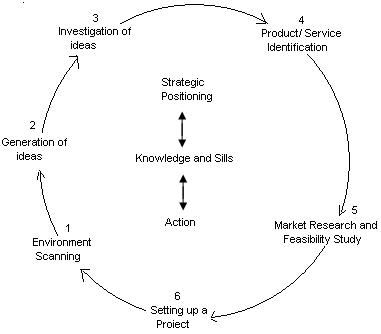Enterprise Process Model
Enterprise Process Model Assignment Help | Enterprise Process Model Homework Help
Enterprise Process Model
There are two phases in the entrepreneurial process:
1. Spotting an opportunity
2. Championing a project.
The first phase covers (i) environment scanning, (ii) generation of ideas and (iii) investigation of ideas to find out potential opportunity.
The second phase covers practical steps involved in setting up an enterprise.
These include preparatory steps of market research, feasibility, business plan and operational steps of resource mobilization and project commissioning.
The steps under both the phases have been integrated under the Enterprise process Model as. The model shows that the entrepreneurial characteristics of knowledge and skills, strategic positioning and action occupy the centre of the diagram orchestrating the whole process. They interact with each other helping the cycle of entrepreneurship maintain its momentum. Strategic

positioning is an overlapping are of knowledge and skills and market dynamics i.e., demand, supply and competition.
The Enterprise Process Model is visualized as a cycle, One factor leading to another.
An entrepreneur starts with environment scanning to generate ideas which are investigated toughly to identify the product or service around which an enterprise would be created conversion of ideas into an enterprise depends upon the relationship between conceptual product or service and practical or realistic market forces. When there is an equilibrium between these two sets of forces, i.e., the forces of knowledge, skill, competency and creativity of the entrepreneur and that of the market, and enterprise is born. However, to sustain, nurture and develop it, there has to be an on going interaction and thus it is a continuous develop, it there has to be an on going interaction and thus it is a continuous process of refining, improving and upgrading the already established enterprise.
The crucial implication of this model is that “opportunity to stratify to implementation” is a circular loop and it has to be sustained with change, flexibility and continuous innovation. Sound strategies provide the most important competitive edge. The entrepreneurs who succeed have a purpose and direction and they build value. They accomplish this with successful strategies which we can define as plans and actions of achieving objectives and fulfilling the purpose of the organization. Strategies are the things that enterprises do, the paths they follow and the decisions they take in order to reach certain points and levels of success. At the beginning of a organization’s life, there is likely to be only one or a very limited range of production or services but this can expand considerably as the organization prospers. The growth can be focused around related activates or show increased diversity.
For more help in Enterprise Process Model click the button below to submit your homework assignment
1. Spotting an opportunity
2. Championing a project.
The first phase covers (i) environment scanning, (ii) generation of ideas and (iii) investigation of ideas to find out potential opportunity.
The second phase covers practical steps involved in setting up an enterprise.
These include preparatory steps of market research, feasibility, business plan and operational steps of resource mobilization and project commissioning.
The steps under both the phases have been integrated under the Enterprise process Model as. The model shows that the entrepreneurial characteristics of knowledge and skills, strategic positioning and action occupy the centre of the diagram orchestrating the whole process. They interact with each other helping the cycle of entrepreneurship maintain its momentum. Strategic
Enterprise Process Model
positioning is an overlapping are of knowledge and skills and market dynamics i.e., demand, supply and competition.
The Enterprise Process Model is visualized as a cycle, One factor leading to another.
An entrepreneur starts with environment scanning to generate ideas which are investigated toughly to identify the product or service around which an enterprise would be created conversion of ideas into an enterprise depends upon the relationship between conceptual product or service and practical or realistic market forces. When there is an equilibrium between these two sets of forces, i.e., the forces of knowledge, skill, competency and creativity of the entrepreneur and that of the market, and enterprise is born. However, to sustain, nurture and develop it, there has to be an on going interaction and thus it is a continuous develop, it there has to be an on going interaction and thus it is a continuous process of refining, improving and upgrading the already established enterprise.
The crucial implication of this model is that “opportunity to stratify to implementation” is a circular loop and it has to be sustained with change, flexibility and continuous innovation. Sound strategies provide the most important competitive edge. The entrepreneurs who succeed have a purpose and direction and they build value. They accomplish this with successful strategies which we can define as plans and actions of achieving objectives and fulfilling the purpose of the organization. Strategies are the things that enterprises do, the paths they follow and the decisions they take in order to reach certain points and levels of success. At the beginning of a organization’s life, there is likely to be only one or a very limited range of production or services but this can expand considerably as the organization prospers. The growth can be focused around related activates or show increased diversity.
For more help in Enterprise Process Model click the button below to submit your homework assignment